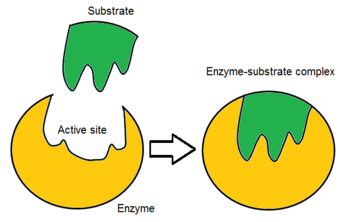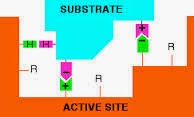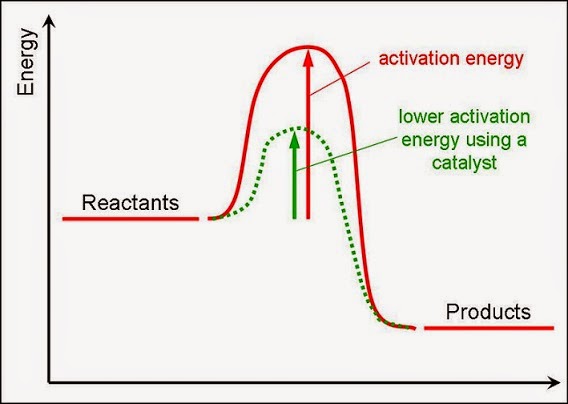Biology
 Enzymes are globular proteins that serve as biological catalysts.
Enzymes are globular proteins that serve as biological catalysts.
They speed up or slow down metabolic reaction, but remain unchanged.
They may facilitate the breaking of an existing bond or the formation of a new bond.
- Enzymes: Structure, Function, Classification, And Specificity
Enzymes are proteins that vary widely in their particular structures, functions, and specificity; however, their general themes remain constant. More importantly, most of the biological reactions that occur, are governed by enzymes, making this an important...
- Q: Explain The Effects Of Too High A Temperature On An Enzyme
If the temperature is too high, an increase in kinetic energy of the molecules will cause excessive vibrations of the molecules. This will disrupt the 3 dimensional structure of the enzyme, causing it to become a random coil. The enzyme is therefore denatured....
- Enzyme Inhibition
In competitive inhibition, inhibitor has a shape, charge, size and structure similar to that of the substrate. It therefore competes with the substrate for the active sites to form the enzyme-inhibitor complex (E-I complex) and reduces the number of active...
- Q: Distinguish Between Competitive And Non-competitive Inhibition Of Enzymes
A competitive inhibitor is structurally similar to the substrate but a non-competitive inhibitor is often structurally different from the substrate. Hence, a competitive inhibitor will compete with the substrate for an active site but a non competitive...
- #17.2 Enzymes - Syllabus 2016
3.1 Mode of action of enzymes 3.2 Factors that affect enzyme action Enzymes are essential for life to exist. Their mode of action and the factors that affect their activity are explored in this section. Prior...
Biology
#18. Enzymes - active site, activation energy, enzyme specificity
 Enzymes are globular proteins that serve as biological catalysts.
Enzymes are globular proteins that serve as biological catalysts. They speed up or slow down metabolic reaction, but remain unchanged.
They may facilitate the breaking of an existing bond or the formation of a new bond.
Substrates = the molecules that bind to the enzyme
Products = new substances formed.
1. Active sites
Active site = area in enzyme's molecule where the substrate bind to enzyme --> enzyme-substrate complex.

The R groups of amino acids at the active site form temporary bonds with the substrate molecule. This pulls the substrate slightly out of shape, causing it to react and form products.

2. Activation energy

3. Enzyme specificity
Lock and Key hypothesis (Emil Fisher, 1894)
Induced fit hypothesis (Koshland, 1958)
Products = new substances formed.
1. Active sites
Active site = area in enzyme's molecule where the substrate bind to enzyme --> enzyme-substrate complex.

The R groups of amino acids at the active site form temporary bonds with the substrate molecule. This pulls the substrate slightly out of shape, causing it to react and form products.

2. Activation energy
- Activation energy = energy the substrates need for changing themselves into products. Heating provides activation energy.
- Enzymes reduce activation energy needed ---> reaction take place at low to. They do this by distort the shape of the substrate when it binds at the enzyme's active site.

3. Enzyme specificity
Lock and Key hypothesis (Emil Fisher, 1894)
- The shape of the active site of the enzyme and the substrate molecules are complementary.
- They possess specific 3-D shapes that fit exactly into one another.
- Like a key into a lock, only the correct size and shape of the substrate (the key) would fit into the active site of the enzyme (the lock).
- This shows the high specificity of enzymes, however it is too rigid.
 |
The active site has a complementary shape to the substrate. |
Induced fit hypothesis (Koshland, 1958)
- The shape of the active site of the enzyme and the substrate molecules are NOT complementary.
- In the presence of the substrate, the active site continually reshapes by its interactions with the substrate, until the substrate is completely fit into it.
- The enzyme is flexible and molds to fit the substrate molecule like gloves fitting one?s hand or clothing on a person.
- This hypothesis is more acceptable.
 |
| The active site forms a complementary shape to the substrate only after binding. |
| Syllabus 2015 (a) explain that enzymes are globular proteins that catalyse metabolic reactions; (b) explain the mode of action of enzymes in terms of an active site, enzyme-substrate complex, lowering of activation energy and enzyme specificity (the lock and key hypothesis and the induced fit hypothesis should be included); |
Syllabus 2016 Mode of action of enzymes There are many different enzymes, each one specific to a particular reaction. This specificity is the key to understanding the efficient functioning of cells and living organisms. a) explain that enzymes are globular proteins that catalyse metabolic reactions b) state that enzymes function inside cells (intracellular enzymes) and outside cells (extracellular enzymes) c) explain the mode of action of enzymes in terms of an active site, enzyme/substrate complex, lowering of activation energy and enzyme specificity (the lock and key hypothesis and the induced fit hypothesis should be included) |
- Enzymes: Structure, Function, Classification, And Specificity
Enzymes are proteins that vary widely in their particular structures, functions, and specificity; however, their general themes remain constant. More importantly, most of the biological reactions that occur, are governed by enzymes, making this an important...
- Q: Explain The Effects Of Too High A Temperature On An Enzyme
If the temperature is too high, an increase in kinetic energy of the molecules will cause excessive vibrations of the molecules. This will disrupt the 3 dimensional structure of the enzyme, causing it to become a random coil. The enzyme is therefore denatured....
- Enzyme Inhibition
In competitive inhibition, inhibitor has a shape, charge, size and structure similar to that of the substrate. It therefore competes with the substrate for the active sites to form the enzyme-inhibitor complex (E-I complex) and reduces the number of active...
- Q: Distinguish Between Competitive And Non-competitive Inhibition Of Enzymes
A competitive inhibitor is structurally similar to the substrate but a non-competitive inhibitor is often structurally different from the substrate. Hence, a competitive inhibitor will compete with the substrate for an active site but a non competitive...
- #17.2 Enzymes - Syllabus 2016
3.1 Mode of action of enzymes 3.2 Factors that affect enzyme action Enzymes are essential for life to exist. Their mode of action and the factors that affect their activity are explored in this section. Prior...
